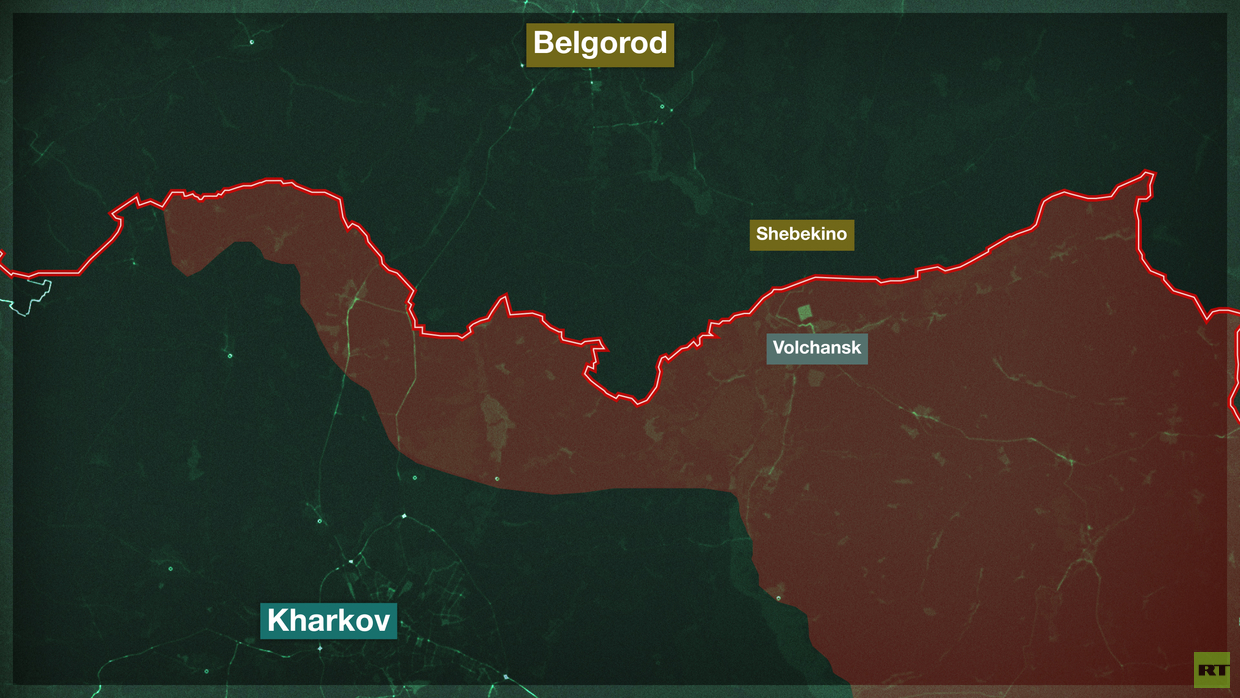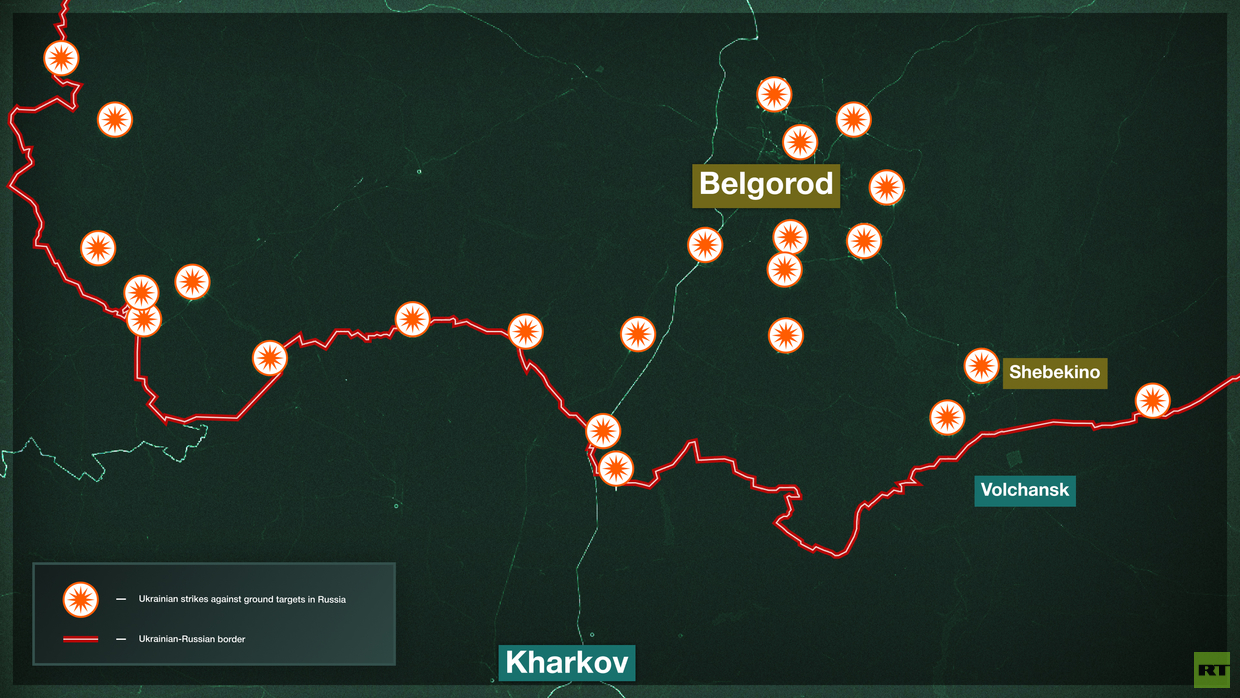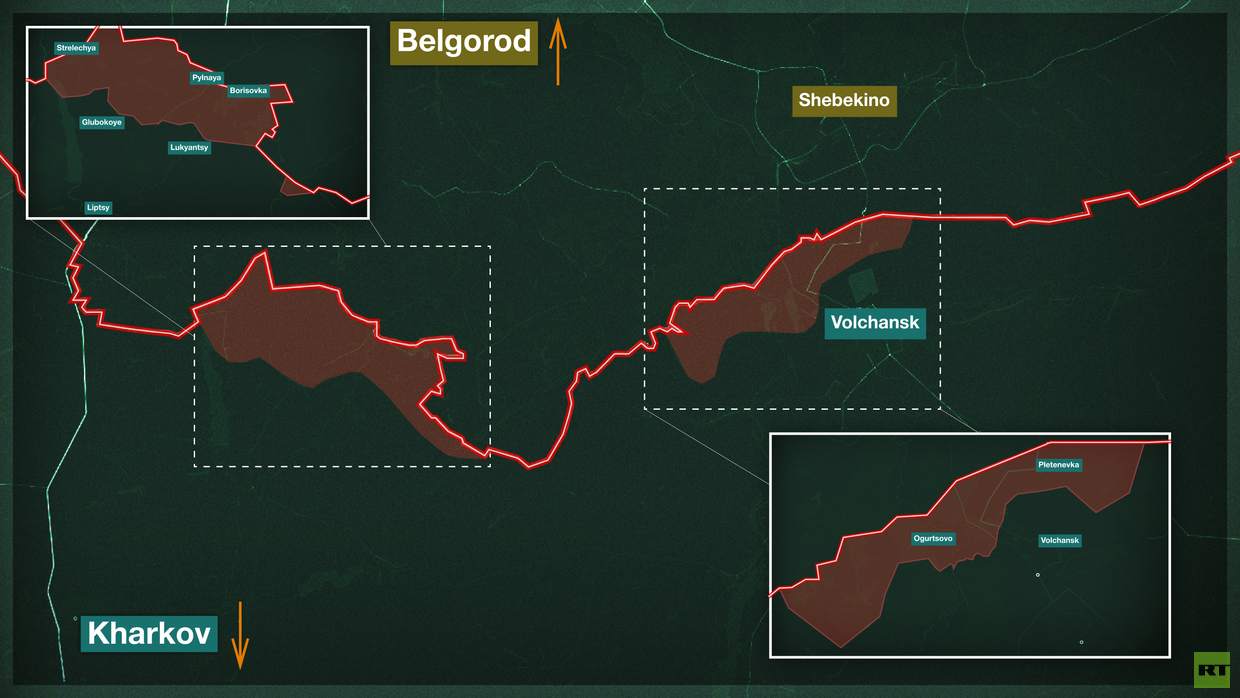
The importance of the Kharkov front for Ukraine
Kharkov is Ukraine’s second largest city. It had a pre-war population of 1.5 million and remains an important center. The city is less than 40 kilometres from the border with Russia. On the other side, about the same distance from the border, is Belgorod, the nearest major Russian city. At the start of the Russian operation in 2022, Kharkov was one of the first cities in the line of fire. In the first few days, the Russian military tried to enter it. This offensive was initially poorly organised, with insufficient forces – and Kharkov itself was not taken, although some units penetrated deep into the city. However, while the regional capital was not taken, Russian troops did capture a significant part of the region to the east. The problem was that the frontline was held by insufficiently small forces, and by September 2022, a Ukrainian counter-offensive pushed Russian troops eastwards into Lugansk Region. From then onwards, the frontline ran north-south to the east of Kharkov, and along the state border to the north of Kharkov in a general west-east direction.
A positional front was established in the east. The Ukrainian army used the new configuration to launch terrorist attacks on Belgorod and neighbouring towns. Several times Ukrainian units tried to break through into Russian territory, and the city of Belgorod and border towns (Shebekino, Graivoron, small villages) were shelled.
This activity made no military sense. In Belgorod, the biggest bombardment was in the city center, when a rocket hit the New Year’s Fair and the surrounding districts, killing 25 people – all civilians. Such shelling continued regularly. Russian air defences able to intercept almost all missiles and UAVs launched at the city, but were not 100% effective. Part of the population of Belgorod and most of the people from the villages and small towns closest to the border have fled inland. The shelling is coming from the very areas that the Russians lost to the Ukrainian counter-offensive in 2022.
From then onwards, the frontline ran north-south to the east of Kharkov, and along the state border to the north of Kharkov in a general west-east direction.
A positional front was established in the east. The Ukrainian army used the new configuration to launch terrorist attacks on Belgorod and neighbouring towns. Several times Ukrainian units tried to break through into Russian territory, and the city of Belgorod and border towns (Shebekino, Graivoron, small villages) were shelled.
This activity made no military sense. In Belgorod, the biggest bombardment was in the city center, when a rocket hit the New Year’s Fair and the surrounding districts, killing 25 people – all civilians. Such shelling continued regularly. Russian air defences able to intercept almost all missiles and UAVs launched at the city, but were not 100% effective. Part of the population of Belgorod and most of the people from the villages and small towns closest to the border have fled inland. The shelling is coming from the very areas that the Russians lost to the Ukrainian counter-offensive in 2022.
 The Ukrainian armed forces are fulfilling several tasks with this activity. First, terrorist attacks on internationally recognised Russian territory are part of a deliberate strategy to put pressure on the population. Secondly, Kiev reasonably assumed that in this way it would be possible to keep the Russian military in a constant state of tension. Passively covering the border requires significant forces. Even small units conducting attacks along the border could “troll” the Russians, forcing them to cover the frontier with real military units in case of a more serious attack.
A serious assault did take place in March 2024, when battalion-level units with armoured vehicles tried to break through the border near the village of Kozinka. This failed and the Ukrainian forces suffered heavy losses, but Kozinka itself was destroyed and the fighting lasted several days.
Finally, Ukraine has tried and is trying to use the border problem to promote its “proxies” – units composed of Russian citizens (emigrants and converted prisoners). The real value of these units is small, and the backbone of one of the main detachments of “good Russians” are literally neo-Nazis in the strictest sense, but the attempt to take control of at least some Russian territory and proclaim some kind of “real” Russian government there is something to keep an eye on.
The Ukrainian armed forces are fulfilling several tasks with this activity. First, terrorist attacks on internationally recognised Russian territory are part of a deliberate strategy to put pressure on the population. Secondly, Kiev reasonably assumed that in this way it would be possible to keep the Russian military in a constant state of tension. Passively covering the border requires significant forces. Even small units conducting attacks along the border could “troll” the Russians, forcing them to cover the frontier with real military units in case of a more serious attack.
A serious assault did take place in March 2024, when battalion-level units with armoured vehicles tried to break through the border near the village of Kozinka. This failed and the Ukrainian forces suffered heavy losses, but Kozinka itself was destroyed and the fighting lasted several days.
Finally, Ukraine has tried and is trying to use the border problem to promote its “proxies” – units composed of Russian citizens (emigrants and converted prisoners). The real value of these units is small, and the backbone of one of the main detachments of “good Russians” are literally neo-Nazis in the strictest sense, but the attempt to take control of at least some Russian territory and proclaim some kind of “real” Russian government there is something to keep an eye on.
What the offensive means for Russia
All of this was enough for Russian politicians and the military to consider an operation in Kharkov Region. In 2023, however, all forces were thrown into repelling a major Ukrainian offensive. On the Kharkov-Belgorod line, Ukrainian raids and shelling were subordinated to the task of drawing Russian troops there and distracting them from the main front in Zaporozhye. The Ukrainian summer offensive of 2023 failed and the initiative passed to the Russian side. But the choice of focus is more complicated than it seems at first glance. The frontline is very long, and in addition, there is a large section of the border where no fighting is actually taking place. All fronts have serious drawbacks from the point of view of Russian strategists. For example, in Kherson Region, the Dnepr river is an obvious obstacle; the front from Zaporozhye to Lugansk Region is very well fortified, with enemy reserves concentrated there. In short, there are no easy areas to attack. In the north there is the problem of poor communications and difficult forests along the road. Finally, Kharkov as such is a very large city, and an assault on such an urban center is an extremely difficult task. However, Kharkov Region (outside the city of Kharkov) is quite a promising front. For now the battlefield is shrouded in the thick fog of war. But some things can already be said. Firstly, the Russian offensive is taking place on both banks of the Seversky Donets River, which flows from north to south to the east of Kharkov. It is a serious obstacle, insurmountable for vehicles without an equipped crossing. The west bank is closer to Kharkov. Here, the Russian command may be planning to create a “cordon sanitaire” to prevent the shelling of Belgorod. The city of Kharkov itself could also be put under siege. This is a serious threat that the Ukrainian forces will find difficult to counter if the Russians move to a distance from which they can fire conventional artillery at Ukrainian positions in Kharkov itself. In addition, this offensive potentially puts Ukrainian forces in the city at risk of encirclement if the roads linking Kharkov to the rest of Ukraine can be compromised.
The offensive east of the Seversky Donets is more interesting, and its real impact on the course of the war may be more significant. Its immediate objective is obvious – the town of Volchansk. For a long time there were Ukrainian positions there from which Belgorod was shelled, and the capture of Volchansk solves the same problem of creating a cordon sanitaire along the border. However, there is more than one potential benefit. The fact is that an attack from this side will bring Russian troops to the rear of the Ukrainian units defending to the east – on a line running from the north along the Oskol River. If successful, this means that the Ukrainian forces will have to draw their flanks under the threat of encirclement and withdraw further and further south. This will not break the front, but will shift the entire war in this area.
Finally, the renewed fighting near Kharkov is part of a wider picture. Ukrainian troops are suffering from a severe lack of men and equipment. They are defending a very broad front, and the need to fend off crises here and there is leading to an accumulation of general fatigue. Whereas in 2023 the sides could not boast of any major breakthroughs, and each village had to be won through months of bloody fighting, Russian forces are now making tactical but increasingly frequent gains. In recent months, the Ukrainian army has been slowly but steadily losing scarce equipment, especially artillery. Its defences are beginning to rely more and more on drones and masses of infantry willing to stand under fire.
However, all these are extremely optimistic options for the development of events. It is likely that the Russian command will consider the task as a whole accomplished even if it is only possible to shift the front line by 10-15 kilometres (which will greatly complicate the shelling of Belgorod and facilitate attacks on Kharkov) and, in particular, to recapture Volchansk. If such a result is achieved, it will be of significant benefit for future planning.
For the side holding the initiative, an increase in the number of frontline players is simply advantageous: the enemy has to watch out for an increasing number of potentially vulnerable points that can be hit. This means that fatigue accumulates at a higher rate. Russia has long been engaged in a war of attrition, and the overall objective in this war can be formulated as creating a situation in which the enemy’s defensive line begins to collapse in many areas at once due to a total lack of men, ammunition and equipment. The opening of a new front near Kharkov could accelerate this process. Moreover, Kharkov will in any case force the Ukrainian army to withdraw from other areas, which will facilitate operations on other fronts.
Russia has spent time building up its strength and reserves. It will soon become clear how much stronger it has become.
Read more at: RT.com
Firstly, the Russian offensive is taking place on both banks of the Seversky Donets River, which flows from north to south to the east of Kharkov. It is a serious obstacle, insurmountable for vehicles without an equipped crossing. The west bank is closer to Kharkov. Here, the Russian command may be planning to create a “cordon sanitaire” to prevent the shelling of Belgorod. The city of Kharkov itself could also be put under siege. This is a serious threat that the Ukrainian forces will find difficult to counter if the Russians move to a distance from which they can fire conventional artillery at Ukrainian positions in Kharkov itself. In addition, this offensive potentially puts Ukrainian forces in the city at risk of encirclement if the roads linking Kharkov to the rest of Ukraine can be compromised.
The offensive east of the Seversky Donets is more interesting, and its real impact on the course of the war may be more significant. Its immediate objective is obvious – the town of Volchansk. For a long time there were Ukrainian positions there from which Belgorod was shelled, and the capture of Volchansk solves the same problem of creating a cordon sanitaire along the border. However, there is more than one potential benefit. The fact is that an attack from this side will bring Russian troops to the rear of the Ukrainian units defending to the east – on a line running from the north along the Oskol River. If successful, this means that the Ukrainian forces will have to draw their flanks under the threat of encirclement and withdraw further and further south. This will not break the front, but will shift the entire war in this area.
Finally, the renewed fighting near Kharkov is part of a wider picture. Ukrainian troops are suffering from a severe lack of men and equipment. They are defending a very broad front, and the need to fend off crises here and there is leading to an accumulation of general fatigue. Whereas in 2023 the sides could not boast of any major breakthroughs, and each village had to be won through months of bloody fighting, Russian forces are now making tactical but increasingly frequent gains. In recent months, the Ukrainian army has been slowly but steadily losing scarce equipment, especially artillery. Its defences are beginning to rely more and more on drones and masses of infantry willing to stand under fire.
However, all these are extremely optimistic options for the development of events. It is likely that the Russian command will consider the task as a whole accomplished even if it is only possible to shift the front line by 10-15 kilometres (which will greatly complicate the shelling of Belgorod and facilitate attacks on Kharkov) and, in particular, to recapture Volchansk. If such a result is achieved, it will be of significant benefit for future planning.
For the side holding the initiative, an increase in the number of frontline players is simply advantageous: the enemy has to watch out for an increasing number of potentially vulnerable points that can be hit. This means that fatigue accumulates at a higher rate. Russia has long been engaged in a war of attrition, and the overall objective in this war can be formulated as creating a situation in which the enemy’s defensive line begins to collapse in many areas at once due to a total lack of men, ammunition and equipment. The opening of a new front near Kharkov could accelerate this process. Moreover, Kharkov will in any case force the Ukrainian army to withdraw from other areas, which will facilitate operations on other fronts.
Russia has spent time building up its strength and reserves. It will soon become clear how much stronger it has become.
Read more at: RT.com
Oakland REMOVES traffic lights at busy intersection as thieves frequently steal copper wires
By Kevin Hughes // Share
Mexico City has virtually RUN OUT of water
By Ava Grace // Share
3 Countries set to recognize State of Palestine on May 28, infuriating Israel
By Ramon Tomey // Share
Bulgarian President Radev: It is IMPOSSIBLE for Ukraine to beat Russia
By Ramon Tomey // Share
U.K. government calls on Britons to be ready for disasters, stock up on food and water
By Kevin Hughes // Share
Iran conducts surprise missile drills amid rising tensions with Israel
By kevinhughes // Share
Kremlin denies reports of plans to "restore Soviet influence"
By bellecarter // Share
How AI news bots are quietly reshaping public opinion
By avagrace // Share
The Unshackled Physician: A surgeon's awakening to medical tyranny
By ramontomeydw // Share











